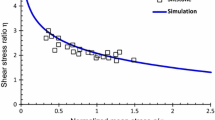Summary
Rock strength data covering the full range of possible stress conditions are presented for three rocks: a granite, a limestone and a salt rock. The Hoek and Brown square root parabola and the Johnston criteria are fitted to the strength data coming from around 500 laboratory tests. The fitting procedure is facilitated by a specially built PC code, ROCKER, which is available to anyone on request.
The Hoek and Brown criterion is modified through the inclusion of a third parameter to account for the low tensile strength of the salt rock. A new criterion, the Rocker function is formulated to follow strength data closely in the tension-low confining pressure region.
Similar content being viewed by others
References
Hoek, E. and Brown, E.T. (1980)Underground Excavations in Rock, Institute of Mining and Metallurgy, London, p. 527.
Jonston, I.W. (1985) Strength of intact geomechanical materials. ASCE,Journal of Geotechnical Engineering,111, 730–749.
Leon, A. (1934) Uber the rolle der trennungsbruche ins rahmen der mohr'shen anstrengungshypothese.Der Bauingenieur,15, 31–32.
Paul, B. (1961) Modification of the Coulomb-Mohr theory of fracture. ASCE,Journal of Applied Mechanics,28, 259–268.
Author information
Authors and Affiliations
Rights and permissions
About this article
Cite this article
Carter, B.J., Scott Duncan, E.J. & Lajtai, E.Z. Fitting strength criteria to intact rock. Geotech Geol Eng 9, 73–81 (1991). https://doi.org/10.1007/BF00880985
Received:
Issue Date:
DOI: https://doi.org/10.1007/BF00880985




